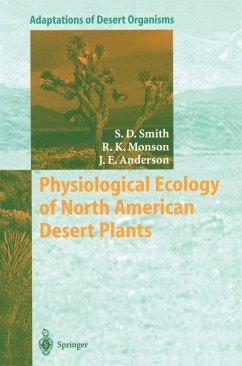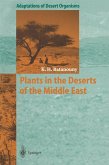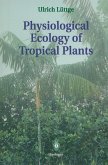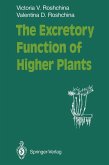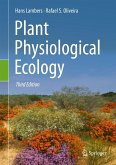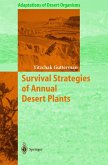Stanley D. Smith, Russell Monson, Jay E. Anderson
Physiological Ecology of North American Desert Plants (eBook, PDF)
40,95 €
40,95 €
inkl. MwSt.
Sofort per Download lieferbar

20 °P sammeln
40,95 €
Als Download kaufen

40,95 €
inkl. MwSt.
Sofort per Download lieferbar

20 °P sammeln
Jetzt verschenken
Alle Infos zum eBook verschenken
40,95 €
inkl. MwSt.
Sofort per Download lieferbar
Alle Infos zum eBook verschenken

20 °P sammeln
Stanley D. Smith, Russell Monson, Jay E. Anderson
Physiological Ecology of North American Desert Plants (eBook, PDF)
- Format: PDF
- Merkliste
- Auf die Merkliste
- Bewerten Bewerten
- Teilen
- Produkt teilen
- Produkterinnerung
- Produkterinnerung

Bitte loggen Sie sich zunächst in Ihr Kundenkonto ein oder registrieren Sie sich bei
bücher.de, um das eBook-Abo tolino select nutzen zu können.
Hier können Sie sich einloggen
Hier können Sie sich einloggen
Sie sind bereits eingeloggt. Klicken Sie auf 2. tolino select Abo, um fortzufahren.

Bitte loggen Sie sich zunächst in Ihr Kundenkonto ein oder registrieren Sie sich bei bücher.de, um das eBook-Abo tolino select nutzen zu können.
Desert environments are among the harshest on earth. Nevertheless many organisms live there. The book describes the adaptations of plants to the extreme conditions in North American deserts.
- Geräte: PC
- ohne Kopierschutz
- eBook Hilfe
- Größe: 43.5MB
Andere Kunden interessierten sich auch für
![Plants in the Deserts of the Middle East (eBook, PDF) Plants in the Deserts of the Middle East (eBook, PDF)]() Kamal H. BatanounyPlants in the Deserts of the Middle East (eBook, PDF)160,95 €
Kamal H. BatanounyPlants in the Deserts of the Middle East (eBook, PDF)160,95 €![General Index (eBook, PDF) General Index (eBook, PDF)]() General Index (eBook, PDF)72,95 €
General Index (eBook, PDF)72,95 €![Physiological Ecology of Tropical Plants (eBook, PDF) Physiological Ecology of Tropical Plants (eBook, PDF)]() Ulrich LüttgePhysiological Ecology of Tropical Plants (eBook, PDF)64,95 €
Ulrich LüttgePhysiological Ecology of Tropical Plants (eBook, PDF)64,95 €![The Excretory Function of Higher Plants (eBook, PDF) The Excretory Function of Higher Plants (eBook, PDF)]() Victoria V RoshchinaThe Excretory Function of Higher Plants (eBook, PDF)72,95 €
Victoria V RoshchinaThe Excretory Function of Higher Plants (eBook, PDF)72,95 €![Plant Physiological Ecology (eBook, PDF) Plant Physiological Ecology (eBook, PDF)]() Hans LambersPlant Physiological Ecology (eBook, PDF)56,95 €
Hans LambersPlant Physiological Ecology (eBook, PDF)56,95 €![Microautoradiography and Electron Probe Analysis (eBook, PDF) Microautoradiography and Electron Probe Analysis (eBook, PDF)]() Microautoradiography and Electron Probe Analysis (eBook, PDF)72,95 €
Microautoradiography and Electron Probe Analysis (eBook, PDF)72,95 €![Survival Strategies of Annual Desert Plants (eBook, PDF) Survival Strategies of Annual Desert Plants (eBook, PDF)]() Yitzchak GuttermanSurvival Strategies of Annual Desert Plants (eBook, PDF)112,95 €
Yitzchak GuttermanSurvival Strategies of Annual Desert Plants (eBook, PDF)112,95 €-
-
-
Desert environments are among the harshest on earth. Nevertheless many organisms live there. The book describes the adaptations of plants to the extreme conditions in North American deserts.
Dieser Download kann aus rechtlichen Gründen nur mit Rechnungsadresse in A, B, BG, CY, CZ, D, DK, EW, E, FIN, F, GR, HR, H, IRL, I, LT, L, LR, M, NL, PL, P, R, S, SLO, SK ausgeliefert werden.
Produktdetails
- Produktdetails
- Verlag: Springer Berlin Heidelberg
- Seitenzahl: 288
- Erscheinungstermin: 6. Dezember 2012
- Englisch
- ISBN-13: 9783642592126
- Artikelnr.: 53393132
- Verlag: Springer Berlin Heidelberg
- Seitenzahl: 288
- Erscheinungstermin: 6. Dezember 2012
- Englisch
- ISBN-13: 9783642592126
- Artikelnr.: 53393132
- Herstellerkennzeichnung Die Herstellerinformationen sind derzeit nicht verfügbar.
Desert environments are among the harshest on earth. Nevertheless many organisms live there. The book describes the adaptations of plants to the extreme conditions in North American deserts.
Prologue.- 1 North American Deserts: Environments and Vegetation.- 1.1 The Deserts of North America.- 1.2 Abiotic Features of North American Deserts.- 1.3 North American Desert Vegetation.- 1.4 Structure and Function of North American Desert Ecosystems.- 2 Plant Processes and Responses to Stress.- 2.1 Photosynthesis in Desert Plants.- 2.2 Desert Plant Water Relations.- 2.3 Desert Plant Growth.- 2.4 Reproduction in Desert Plants.- 2.5 Defense of Desert Plants.- 3 Evergreen Shrubs.- 3.1 Introduction.- 3.2 Case Study: Artemisia tridentata.- 3.3 Case Study: Larrea tridentata.- 3.4 Summary: Adaptations and Environmental Constraints.- 4 Drought-Deciduous Shrubs.- 4.1 Introduction.- 4.2 Case Study: Encelia farinosa.- 4.3 Stem Photosynthetic Shrubs and Trees.- 4.4 Summary: Adaptations and Environmental Constraints.- 5 CAM Succulents.- 5.1 Introduction.- 5.2 Case Study: Carnegiea gigantea.- 5.3 Case Study: Agave deserti.- 5.4 Summary: Adaptations and Environmental Constraints.- 6 Perennial Grasses.- 6.1 Introduction.- 6.2 Architecture of Perennial Grasses.- 6.3 Hypotheses to Account for Selection for Bunchgrass Architecture.- 6.4 Case Study: Leymus cinereus.- 6.5 Summary: Adaptations and Environmental Constraints.- 7 Phreatophytes.- 7.1 Introduction.- 7.2 Case Study: Prosopis glandulosa.- 7.3 Summary: Adaptations and Environmental Constraints.- 8 Desert Annuals.- 8.1 General Distribution of Desert Annuals.- 8.2 Phenological Controls over Growth of Desert Annuals.- 8.3 Plant Carbon and Water Balance of Desert Annuals.- 8.4 Case Study: Machaeranthera gracilis.- 8.5 Case Study: Solar Trackers.- 8.6 Summary: Adaptations and Environmental Constraints.- 9 Poikilohydric Plants.- 9.1 Introduction.- 9.2 Case Study: Selaginella lepidophylla.- 9.3 Summary: Adaptations and Environmental Constraints.- 10 Exotic Plants.- 10.1 Introduction.- 10.2 Case Study: Bromus tectorum.- 10.3 Case Study: Tamarix ramosissima.- 10.4 Summary: Adaptations and Environmental Constraints.- Epilogue.- Desert Adaptation: A Growth Form Perspective.- Global Climate Change: Potential Responses of Desert Ecosystems.- Concluding Remarks.- Acknowledgements.- References.- Species Index.
Prologue.- 1 North American Deserts: Environments and Vegetation.- 1.1 The Deserts of North America.- 1.2 Abiotic Features of North American Deserts.- 1.3 North American Desert Vegetation.- 1.4 Structure and Function of North American Desert Ecosystems.- 2 Plant Processes and Responses to Stress.- 2.1 Photosynthesis in Desert Plants.- 2.2 Desert Plant Water Relations.- 2.3 Desert Plant Growth.- 2.4 Reproduction in Desert Plants.- 2.5 Defense of Desert Plants.- 3 Evergreen Shrubs.- 3.1 Introduction.- 3.2 Case Study: Artemisia tridentata.- 3.3 Case Study: Larrea tridentata.- 3.4 Summary: Adaptations and Environmental Constraints.- 4 Drought-Deciduous Shrubs.- 4.1 Introduction.- 4.2 Case Study: Encelia farinosa.- 4.3 Stem Photosynthetic Shrubs and Trees.- 4.4 Summary: Adaptations and Environmental Constraints.- 5 CAM Succulents.- 5.1 Introduction.- 5.2 Case Study: Carnegiea gigantea.- 5.3 Case Study: Agave deserti.- 5.4 Summary: Adaptations and Environmental Constraints.- 6 Perennial Grasses.- 6.1 Introduction.- 6.2 Architecture of Perennial Grasses.- 6.3 Hypotheses to Account for Selection for Bunchgrass Architecture.- 6.4 Case Study: Leymus cinereus.- 6.5 Summary: Adaptations and Environmental Constraints.- 7 Phreatophytes.- 7.1 Introduction.- 7.2 Case Study: Prosopis glandulosa.- 7.3 Summary: Adaptations and Environmental Constraints.- 8 Desert Annuals.- 8.1 General Distribution of Desert Annuals.- 8.2 Phenological Controls over Growth of Desert Annuals.- 8.3 Plant Carbon and Water Balance of Desert Annuals.- 8.4 Case Study: Machaeranthera gracilis.- 8.5 Case Study: Solar Trackers.- 8.6 Summary: Adaptations and Environmental Constraints.- 9 Poikilohydric Plants.- 9.1 Introduction.- 9.2 Case Study: Selaginella lepidophylla.- 9.3 Summary: Adaptations and Environmental Constraints.- 10 Exotic Plants.- 10.1 Introduction.- 10.2 Case Study: Bromus tectorum.- 10.3 Case Study: Tamarix ramosissima.- 10.4 Summary: Adaptations and Environmental Constraints.- Epilogue.- Desert Adaptation: A Growth Form Perspective.- Global Climate Change: Potential Responses of Desert Ecosystems.- Concluding Remarks.- Acknowledgements.- References.- Species Index.
